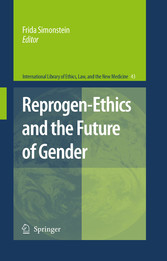Suchen und Finden
Epigraph
6
Acknowledgements
7
Contents
8
Notes on the Contributors
10
Introduction
14
Part I ART – A 30 Years Retrospective
25
Chapter 1 Current Status of Assisted Reproductive Techniques (ART)
26
Introduction
26
Indications of ART
26
Ovulation Induction
27
Severe Male Infertility and Intracytoplasmic Sperm Injection [ICSI]
28
Gamete Donation
28
In Vitro Maturation of Oocytes
29
Culture Media
29
Embryo Biopsy and PGD/PGS
30
Blastocyst Culture
31
Single Embryo Transfer
31
Ultrasound Guided Embryo Transfer
32
Endometrial Biopsy to Test Endometrial Receptivity
32
Oocytes Cryopreservation
33
Ovarian Cryopreservation and Transplantation
33
Gestational Carrier Pregnancy
34
Use of Human Embryos for Research – Stem Cells
34
Posthumous Conception
34
Conclusion
35
References
35
Chapter 2 The Medicalization of Reproduction – A 30 Year Retrospective
39
Introduction
39
Liberty, Effective Freedom and the Social Embedding of ART
40
ART and the Medicalization of Reproduction
42
Conclusion
45
References
46
Chapter 3 Conceiving a New Right to Procreate
47
Introduction
47
The Traditional View and its Shortcomings
48
The Capacity to Procreate
52
Problems of Implementation and how These can be Solved by the New Approach
55
Conclusion
59
References
59
Part II ART – Mind the Gap
63
Chapter 4 ‘Can’t Avoid It, Can’t Afford It’: Assisted Reproduction in Israel and Bulgaria
64
Introduction
64
Starting Point
65
ARTs in Bulgaria
66
ARTs in Israel
67
IVF Performance
68
Some Effects in Israel – Too Much of a Good Thing?
69
Some Effects in Bulgaria – Not Enough of a Good Thing?
69
Some Conclusions
71
References
71
Chapter 5 Assisted Reproduction in Developing Countries: The Debate at a Turning Point
74
Introduction
74
The Gender Dimension
75
ART Clinics in Developing Countries: To Be or Not to Be?
76
The Future
79
ART in Context
79
Heterogeneity of Developing Countries – One Size Does not Fit All
81
The Equity Issue
82
Conclusions
83
References
84
Chapter 6 Ethical and Socio-Cultural Aspects that Influence ART in Latin America
87
Introduction
87
Continents and Countries
88
Latin America
90
Conclusions
93
References
94
Part III Gendered Futures
96
Chapter 7 Women, Work, and Children: Is There a Solution?
97
Introduction
97
Some Personal History
98
Collected Observations
99
The Hazards of Delayed Procreation
100
The Sandwich Generation and Male Fecklessness
101
Alternative Posibilities
103
A Failure of Feminism?
103
An End to Misplaced Tolerance
105
The Importance of Early Procreation
105
Changing the Job Market
106
An Alternative Track
107
Men: The Eternal Problem
108
References
109
Chapter 8 Between Fecklessness and Selfishness: Is There a Biologically Optimal Time for Motherhood?
111
Introduction
111
The Biological Optimum and Unnecesary Risk
112
Implicit Pro-natalism
113
How the Biological Optimum is Socially Constructed
115
A Question of Degree?
116
What Kind ofWoman ‘Delays’ Pregnancy?
117
Selfishness and Mother/Child Conflict of Interest
119
Conflicting Ideologies of Motherhood
121
References
122
Chapter 9 Gendered Futures: Reproduction and Production in Women’s Lives
124
Introduction
124
What’s Going on? The Gendering of Social Life
126
Future Positive? Scenarios of Possibility
129
Conclusions: The resillience of Gendering
135
References
136
Part IV Parenting
138
Chapter 10 Is Transferred Parental Responsibility Legitimately Enforceable?
139
Context
139
Questions
139
Shortcut Attempts
141
Parental Responsibility
143
Breeders’ Pact
145
Reaching the Limit
148
Implications
150
References
152
Chapter 11 Reproduction, Responsibility and Rationality
154
Introduction: Parental Rights and Responsibilities
154
A “Minimally Satisfying Life”
155
The Best Life or a Good Life
158
Reproductive Choice
162
Conclusion
162
References
163
Chapter 12 Male or FemaleWeWill Create Them: The Ethics of Sex Selection for Non-medical Reasons
164
Introduction
164
Fears and Negative Connotations
165
Methods of Sex Selection
166
Demographic Imbalance: Real or Imagined?
169
The Fear of Stigmatization: The Feminist Argument
171
Conclusion: The Liberal View of Sex Selection
172
References
174
Part V Non-gendered Futures
177
Chapter 13 Artificial Reproductive Technologies and the Advent of the ArtificialWomb
178
Introduction
178
Neonatal Care
178
Will this Line of Treatment Persist?
179
New Developments in Gynecology and IVF
180
Developments in Embryology and the Huge Gap
181
The Human Genome Project and Stem Cell Research
181
Developments in Computer Science
182
Facing Ectogenesis
182
New Conondrums
183
Some Lessons From IVF
184
Final Remarks
185
References
185
Chapter 14 Human Before Sex? Ectogenesis as aWay to Equality
188
Introduction
188
Ectogenesis
189
Ectogenesis is in Everyone’s Interests
190
What About the Children
192
Adverse Consequences of Ectogenesis
193
Concluding Thoughts
195
References
195
Chapter 15 The Glass Womb
197
Introduction
197
A Rationale for the Bill
198
How Glass Wombs Make a Difference
201
Terminations and Glass Wombs
202
Ectogenesis and Gender
207
References
209
Chapter 16 A Survey of People’s Attitude Towards the ArtificialWomb and Ectogenesis in Israel
210
Introduction
210
Research Methods
211
Results
213
Discussion and Conclusions
215
References
217
Index
219
Alle Preise verstehen sich inklusive der gesetzlichen MwSt.








